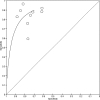Ultrasound assessment of diaphragmatic dysfunction as a predictor of weaning outcome from mechanical ventilation: a systematic review and meta-analysis
- PMID: 30287605
- PMCID: PMC6173234
- DOI: 10.1136/bmjopen-2017-021189
Ultrasound assessment of diaphragmatic dysfunction as a predictor of weaning outcome from mechanical ventilation: a systematic review and meta-analysis
Abstract
Objective: The aim of this systematic review was to assess the diaphragmatic dysfunction (DD) as a predictor of weaning outcome.
Background: Successful weaning depends on several factors: muscle strength, cardiac, respiratory and metabolic. Acquired weakness in mechanical ventilation is a growing important cause of weaning failure. With the development of ultrasonography, DD can be evaluated with ultrasound in weakness patients to predict weaning outcomes.
Methods: The Cochrane Library, PubMed, Embase, Ovid Medline, WanFang Data and CNKI were systematically searched from the inception to September 2017. Ultrasound assessment of DD in adult mechanical ventilation patients was included. Two independent investigators assessed study quality in accordance with the Quality Assessment of Diagnostic Accuracy Studies-2 tool. The primary outcome was diaphragmatic thickness and excursion in the weaning success and failure group. The secondary outcome was the influence of DD on weaning outcome.
Results: Eleven studies involving a total of 436 patients were included. There were eight studies comparing diaphragmatic excursion (DE), five comparing the diaphragmatic thickening fraction (DTF) and two comparing DD between groups with and without successful weaning. Overall, the DE or DTF had a pooled sensitivity of 0.85 (95% CI 0.77 to 0.91) and a pooled specificity of 0.74 (95% CI 0.66 to 0.80) for predicting weaning success. There was high heterogeneity among the included studies (I2=80%; p=0.0006). The rate of weaning failure was significantly increased in patients with DD (OR 8.82; 95% CI 3.51 to 22.13; p<0.00001).
Conclusions: Both DE and DTF showed good diagnostic performance to predict weaning outcomes in spite of limitations included high heterogeneity among the studies. DD was found to be a predictor of weaning failure in critically ill patients.
Keywords: diaphragmatic dysfunction; diaphragmatic excursion; diaphragmatic thickness fraction; weaning mechanical ventilation.
© Author(s) (or their employer(s)) 2018. Re-use permitted under CC BY-NC. No commercial re-use. See rights and permissions. Published by BMJ.
Conflict of interest statement
Competing interests: The authors declared no competing interests.
Figures








Similar articles
-
Diaphragmatic parameters by ultrasonography for predicting weaning outcomes.BMC Pulm Med. 2018 Nov 23;18(1):175. doi: 10.1186/s12890-018-0739-9. BMC Pulm Med. 2018. PMID: 30470204 Free PMC article.
-
Application of bedside ultrasound in predicting the outcome of weaning from mechanical ventilation in elderly patients.BMC Pulm Med. 2021 Jul 9;21(1):217. doi: 10.1186/s12890-021-01605-4. BMC Pulm Med. 2021. PMID: 34243739 Free PMC article.
-
The predictive value of diaphragm ultrasound for weaning outcomes in critically ill children.BMC Pulm Med. 2019 Dec 30;19(1):270. doi: 10.1186/s12890-019-1034-0. BMC Pulm Med. 2019. PMID: 31888586 Free PMC article.
-
Ultrasonography to Access Diaphragm Dysfunction and Predict the Success of Mechanical Ventilation Weaning in Critical Care: A Narrative Review.J Ultrasound Med. 2024 Feb;43(2):223-236. doi: 10.1002/jum.16363. Epub 2023 Nov 2. J Ultrasound Med. 2024. PMID: 37915259 Review.
-
Accuracy of respiratory muscle assessments to predict weaning outcomes: a systematic review and comparative meta-analysis.Crit Care. 2024 Mar 7;28(1):70. doi: 10.1186/s13054-024-04823-4. Crit Care. 2024. PMID: 38454487 Free PMC article.
Cited by
-
Sleep alterations just after extubation do not predict short-term respiratory failure, but….Ann Intensive Care. 2021 May 26;11(1):85. doi: 10.1186/s13613-021-00878-6. Ann Intensive Care. 2021. PMID: 34041620 Free PMC article. No abstract available.
-
Early Mobilization and Rehabilitation of Critically-Ill Patients.Tuberc Respir Dis (Seoul). 2024 Apr;87(2):115-122. doi: 10.4046/trd.2023.0144. Epub 2023 Dec 28. Tuberc Respir Dis (Seoul). 2024. PMID: 38228092 Free PMC article.
-
Current and future applications of ultrasound imaging in peripheral nerve disorders.World J Radiol. 2020 Jun 28;12(6):101-129. doi: 10.4329/wjr.v12.i6.101. World J Radiol. 2020. PMID: 32742576 Free PMC article. Review.
-
Association between rectus femoris cross-sectional area and diaphragmatic excursion with weaning of tracheostomized patients in the intensive care unit.Rev Bras Ter Intensiva. 2022 Oct-Dec;34(4):452-460. doi: 10.5935/0103-507X.20220087-pt. Epub 2023 Mar 3. Rev Bras Ter Intensiva. 2022. PMID: 36888825 Free PMC article.
-
Update on Lean Body Mass Diagnostic Assessment in Critical Illness.Diagnostics (Basel). 2023 Feb 26;13(5):888. doi: 10.3390/diagnostics13050888. Diagnostics (Basel). 2023. PMID: 36900032 Free PMC article. Review.
References
Publication types
MeSH terms
LinkOut - more resources
Full Text Sources
